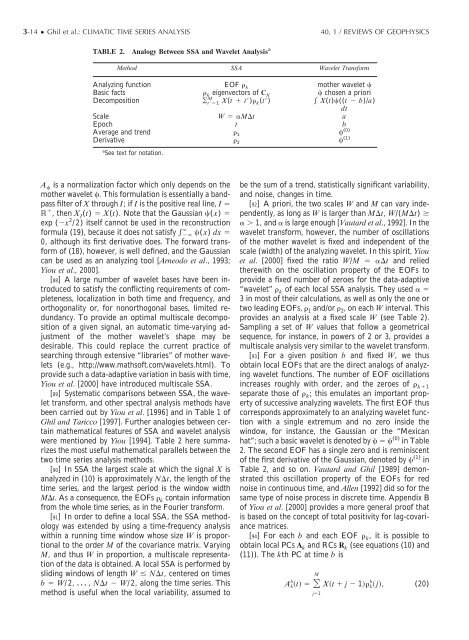advanced spectral methods for climatic time series - Atmospheric ...
advanced spectral methods for climatic time series - Atmospheric ...
advanced spectral methods for climatic time series - Atmospheric ...
Create successful ePaper yourself
Turn your PDF publications into a flip-book with our unique Google optimized e-Paper software.
3-14 ● Ghil et al.: CLIMATIC TIME SERIES ANALYSIS 40, 1 / REVIEWS OF GEOPHYSICS<br />
TABLE 2. Analogy Between SSA and Wavelet Analysis a<br />
Method SSA Wavelet Trans<strong>for</strong>m<br />
Analyzing function EOF k mother wavelet <br />
Basic facts k eigenvectors of CX chosen a priori<br />
M<br />
Decomposition ¥ t1 X(t t) k(t) X(t)((t b)/a)<br />
dt<br />
Scale W Mt a<br />
Epoch t b<br />
Average and trend 1 (0)<br />
Derivative 2 (1)<br />
a See text <strong>for</strong> notation.<br />
A is a normalization factor which only depends on the<br />
mother wavelet . This <strong>for</strong>mulation is essentially a bandpass<br />
filter of X through I; ifIis the positive real line, I <br />
, then XI(t) X(t). Note that the Gaussian ( x) <br />
exp (x 2 / 2) itself cannot be used in the reconstruction<br />
<br />
<strong>for</strong>mula (19), because it does not satisfy ( x) dx <br />
0, although its first derivative does. The <strong>for</strong>ward trans<strong>for</strong>m<br />
of (18), however, is well defined, and the Gaussian<br />
can be used as an analyzing tool [Arneodo et al., 1993;<br />
Yiou et al., 2000].<br />
[88] A large number of wavelet bases have been introduced<br />
to satisfy the conflicting requirements of completeness,<br />
localization in both <strong>time</strong> and frequency, and<br />
orthogonality or, <strong>for</strong> nonorthogonal bases, limited redundancy.<br />
To provide an optimal multiscale decomposition<br />
of a given signal, an automatic <strong>time</strong>-varying adjustment<br />
of the mother wavelet’s shape may be<br />
desirable. This could replace the current practice of<br />
searching through extensive “libraries” of mother wavelets<br />
(e.g., http://www.mathsoft.com/wavelets.html). To<br />
provide such a data-adaptive variation in basis with <strong>time</strong>,<br />
Yiou et al. [2000] have introduced multiscale SSA.<br />
[89] Systematic comparisons between SSA, the wavelet<br />
trans<strong>for</strong>m, and other <strong>spectral</strong> analysis <strong>methods</strong> have<br />
been carried out by Yiou et al. [1996] and in Table 1 of<br />
Ghil and Taricco [1997]. Further analogies between certain<br />
mathematical features of SSA and wavelet analysis<br />
were mentioned by Yiou [1994]. Table 2 here summarizes<br />
the most useful mathematical parallels between the<br />
two <strong>time</strong> <strong>series</strong> analysis <strong>methods</strong>.<br />
[90] In SSA the largest scale at which the signal X is<br />
analyzed in (10) is approximately Nt, the length of the<br />
<strong>time</strong> <strong>series</strong>, and the largest period is the window width<br />
Mt. As a consequence, the EOFs k contain in<strong>for</strong>mation<br />
from the whole <strong>time</strong> <strong>series</strong>, as in the Fourier trans<strong>for</strong>m.<br />
[91] In order to define a local SSA, the SSA methodology<br />
was extended by using a <strong>time</strong>-frequency analysis<br />
within a running <strong>time</strong> window whose size W is proportional<br />
to the order M of the covariance matrix. Varying<br />
M, and thus W in proportion, a multiscale representation<br />
of the data is obtained. A local SSA is per<strong>for</strong>med by<br />
sliding windows of length W Nt, centered on <strong>time</strong>s<br />
b W/2, , Nt W/ 2, along the <strong>time</strong> <strong>series</strong>. This<br />
method is useful when the local variability, assumed to<br />
be the sum of a trend, statistically significant variability,<br />
and noise, changes in <strong>time</strong>.<br />
[92] A priori, the two scales W and M can vary independently,<br />
as long as W is larger than Mt, W/(Mt) <br />
1, and is large enough [Vautard et al., 1992]. In the<br />
wavelet trans<strong>for</strong>m, however, the number of oscillations<br />
of the mother wavelet is fixed and independent of the<br />
scale (width) of the analyzing wavelet. In this spirit, Yiou<br />
et al. [2000] fixed the ratio W/M t and relied<br />
therewith on the oscillation property of the EOFs to<br />
provide a fixed number of zeroes <strong>for</strong> the data-adaptive<br />
“wavelet” k of each local SSA analysis. They used <br />
3 in most of their calculations, as well as only the one or<br />
two leading EOFs, 1 and/or 2, on each W interval. This<br />
provides an analysis at a fixed scale W (see Table 2).<br />
Sampling a set of W values that follow a geometrical<br />
sequence, <strong>for</strong> instance, in powers of 2 or 3, provides a<br />
multiscale analysis very similar to the wavelet trans<strong>for</strong>m.<br />
[93] For a given position b and fixed W, we thus<br />
obtain local EOFs that are the direct analogs of analyzing<br />
wavelet functions. The number of EOF oscillations<br />
increases roughly with order, and the zeroes of k1<br />
separate those of k; this emulates an important property<br />
of successive analyzing wavelets. The first EOF thus<br />
corresponds approximately to an analyzing wavelet function<br />
with a single extremum and no zero inside the<br />
window, <strong>for</strong> instance, the Gaussian or the “Mexican<br />
hat”; such a basic wavelet is denoted by (0) in Table<br />
2. The second EOF has a single zero and is reminiscent<br />
of the first derivative of the Gaussian, denoted by (1) in<br />
Table 2, and so on. Vautard and Ghil [1989] demonstrated<br />
this oscillation property of the EOFs <strong>for</strong> red<br />
noise in continuous <strong>time</strong>, and Allen [1992] did so <strong>for</strong> the<br />
same type of noise process in discrete <strong>time</strong>. Appendix B<br />
of Yiou et al. [2000] provides a more general proof that<br />
is based on the concept of total positivity <strong>for</strong> lag-covariance<br />
matrices.<br />
[94] For each b and each EOF k, it is possible to<br />
obtain local PCs A k and RCs R k (see equations (10) and<br />
(11)). The kth PC at <strong>time</strong> b is<br />
M<br />
b b<br />
Akt j1 Xt j 1k j, (20)






